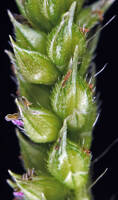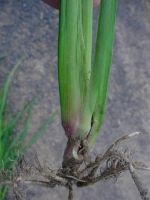Distribution: Occurring on both sides of the Cascades crest in Washington; British Columbia to California, east across most of North America to the Atlantic Coast.
Habitat: Fields, roadsides, meadows, wastelots, and other disturbed areas, often where moist or wet.
Flowers: June-October
Origin: Introduced from Eurasia
Growth Duration: Annual
Conservation Status: Not of concern
Pollination: Wind
Annual, the culms decumbent to erect, pith-filled or hollow, 6-16 dm. tall, the nodes glabrous.
Sheaths open, somewhat compressed; ligules none; blades flat, 4-16 mm. broad.
Inflorescence a stiff panicle, the branches spreading to erect, at least 3 cm. long; spikelets subsessile, 3-4 mm. long, borne along one side of the panicle branches; spikelets 2-flowered, the lower flower sterile; glumes unequal, 3-nerved, unawned; sterile lemma acuminate and awn-tipped, the awn sometimes up to 30 mm. long, about equal to the second glume, the palea membranous, about half as long as the lemma; fertile lemma and palea acuminate, hardened, unawned; stamens 3.
Publication: Ess. Agrostogr. 53, 161, 169, pl. 11, f. 2. 1812. 1812.
Echinochloa crusgalli (L.) P. Beauv. [HC]
Echinochloa muricata (P. Beauv.) Fernald var. occidentalis Wiegand
Echinochloa occidentalis (Wiegand) Rydb.
PNW Herbaria: Specimen records of Echinochloa crus-galli in the Consortium of Pacific Northwest Herbaria database
WA Flora Checklist: Echinochloa crus-galli checklist entry
OregonFlora: Echinochloa crus-galli information
E-Flora BC: Echinochloa crus-galli atlas page
CalPhotos: Echinochloa crus-galli photos



































































